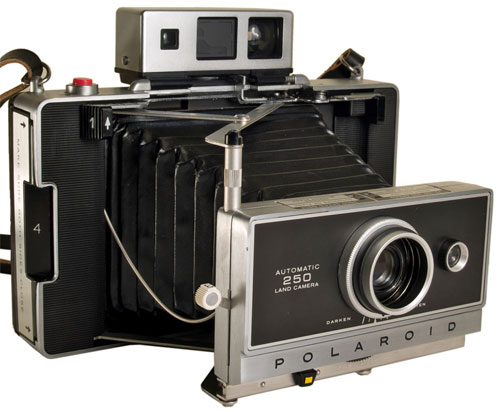Choose a model to see more information about it. Clicking on a film type will bring you to the specific page for that type. |
|---|

200 Series |
Packfilm Cameras
The following technical information is useful for specifics concerning each model. Where appropriate you can click to see more information including photos.
All of these models can take both the rectangular 100/660 type films as well as the square 80 type films.
Please see this chart to give you a visual comparison between the major "options" and abilities of each packfilm model.

If you see this icon, the model was intended for "Special Markets" distribution (i.e. corporate premiums, prizes, and other non-retail distribution) only.

If you see this icon, the model was sold in International (non-USA) markets only.
Production Estimates provided are based on statistical observation (from accumulated reports of serial numbers recorded from actual cameras), and are not intended or expected to have perfect accuracy. Numbers in parentheses indicate "soft" limits, numbers not in parentheses indicate "hard" limits.
Example: Estimated Production: 800,000 - (900,000)
This means that there almost certainly has to have been at least 800,000 of that model made, but there probably were fewer than 900,000 made (but beware that there still could be more). Keep in mind that numbers are subject to change as new data is collected.
200-series models
generally similar to 100-series
ALL Folding Pack Cameras (original style) have the following features in common:
- Pull-out front standard with scissor strut design
- Removable hinged plastic cover protects entire front of camera when camera is not in use.
- Unit focus; focus is controlled by pushing on either side of a sliding arm located near the base of the bellows struts.
- Shutter must be manually cocked; shutter release is on top of camera body.
- Has PC socket for flash; flashgun is clipped to the top of the camera.
Produced: 1967-1969 / Original Retail: $49.95
Estimated Production: Pattern May Not Be Completely Determined (over 1,500,000)
Similar to Model 104.
Collector's Note: Probably the most common folding pack camera. This was the first color-capable Polaroid camera to retail under $50, which no doubt did much to fuel its popularity at the time.

Produced: 1968-1970 / Original Retail: $55.95
Estimated Production: 250,000 - (350,000)
Similar to Model 210, except:
- Has leather neck strap.
Produced: 1967-1969 / Original Retail: $74.95
Estimated Production: 740,000 - (900,000)
Similar to Model 100, except:
- Lens: 114mm f/8.8 2-element plastic
- Has plastic body and plastic shutter/lens housing; no tripod socket.
- View/rangefinder lacks the folding hinge.
Note: You may notice that this model (along with its Special Markets 'twin', the 225) is a bit odd in that it's the only folding pack camera which mates the more versatile shutter assembly (the one equipped with a "Scene Selector") with the less desireable (two-element) lens. All other cameras with the "Scene Selector"-style shutter have the 3-element glass lens instead.

Produced: 1968-1970 / Original Retail: $84.95
Estimated Production: Insufficient Data (over 49,000)
Similar to Model 220, except:
- Has leather neck strap.
Note: It appears that this camera may have been originally offered with a dark-brown artificial leather case that I've never seen accompanied with other pack camera models. Incidently, in addition to the note regarding the Model 220, you might also notice that the 225 would qualify as the only Special Markets camera with the "Scene Selector"-equipped shutter.
Produced: 1967-1969 / Original Retail: $99.95
Estimated Production: 400,000 - (600,000)
Similar to Model 100, except:
- Has plastic body and plastic shutter/lens housing; no tripod socket.
Produced: 1967-1969 / Original Retail: $129.95
Estimated Production: 80,000 - (120,000)
Similar to Model 100.
Produced: 1967-1969 / Original Retail: $159.95
Estimated Production: 750,000 - (850,000)
Similar to Model 100, except:
- Has flip-up single-window view/rangefinder made by Zeiss Ikon. Finder has projected framelines and automatic parallax compensation.
Note: There were a few minor changes made to this camera during its production life.
On the earlier models:
- the viewfinder has a larger eyepiece
- the hinged plastic camera cover has no model number (only the Polaroid name and intersecting circles logo)
- the camera body has a decal instructing where to attach the #268 flash.
[Both of these latter two items are just as with the Model 100.]
Later versions of the 250 have the model number on the plastic cover. In addition, the look of the instruction manual cover was revised, and the viewfinder has a smaller eyepiece. All of the later Polaroid cameras with the Zeiss finder (i.e. the 350, 360, and 450) all have the 'small' eyepiece. Both finders are functionally identical, and both have the same magnification.
The larger eyepiece version is more convenient for eyeglass wearers, however.














Option-al Landlist
Rollfilm
Cameras
Accessories
Film
Packfilm
Cameras
Accessories
Film
SX-70
Cameras
Accessories
Film
600/779
Cameras
Accessories
Film
Spectra
Cameras
Accessories
Film
Oddballs
Cameras
Accessories
Film
Polavision
Cameras
Accessories
Film
All Films
All Cameras
All Accessories
The FAQ
Contact me…